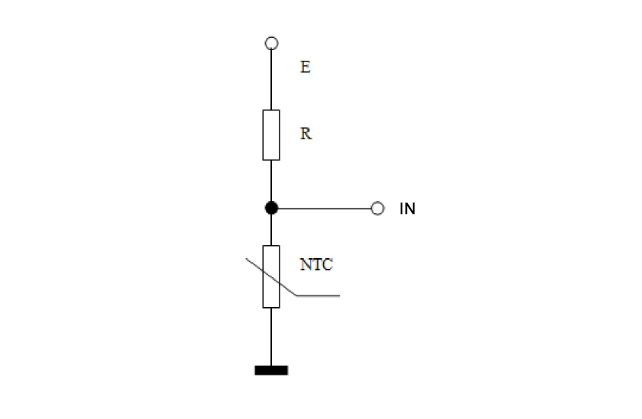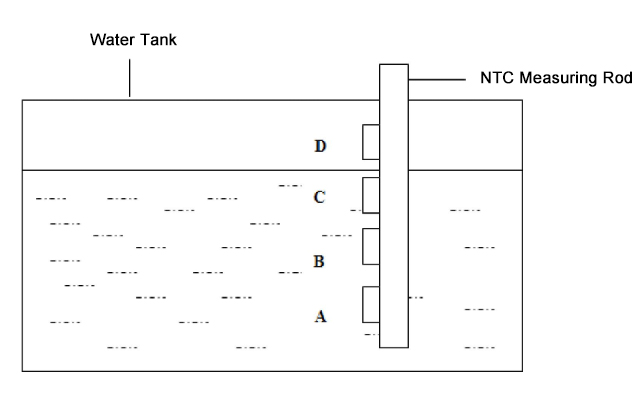1. Advantages of using NTC thermistor to detect water levels
NTC is a widely used thermistor. Its main feature is that its resistance value changes significantly with the (sensing) temperature. When the temperature rises, the resistance value changes. NTC is called negative temperature coefficient thermistor. NTC has the characteristics of low price, simple circuit structure and stable performance, and is widely used in temperature measurement. In fact, NTC can also be used for liquid level measurement. The author believes that NTC has the technical conditions to replace the electrode type for water level measurement of solar water heaters. In addition to the advantages of small size and simple structure of the electrode type, it also has some other advantages of its own.
When NTC is used for water level detection, it not only retains some of its advantages when measuring temperature, but also shows some advantages that are not available in current water level detection methods. First of all, NTC is a semiconductor device. The solid device is characterized by no mechanical movement and long life; secondly, in addition to the simple circuit structure, it can also take into account the function of measuring water temperature; the most important thing is that it completely gets rid of the trouble caused by scale.
2. The working principle of NTC thermistor water level detection
Use temperature difference. Under normal circumstances, the temperature of the air and water in the water tank of a solar water heater is inconsistent. Some people imagine that the temperature in the water tank is measured by NTC and the temperature difference between air and water is used to detect the water level. In-depth analysis, there are several insurmountable problems: ①It is not easy to distinguish the state filled with water and without water; ②The temperature of water at different depths is often different, and the temperature of the upper part of the heat collection process is higher than the temperature of the lower part; ③The ambient temperature deviation When it is low, the temperature near the measuring hole changes greatly. Although rigorous logical judgment circuits and software can solve these problems, physical judgments are more direct, reliable, concise and inexpensive. At present, there is no market application case of using temperature difference to detect water level, but this idea is useful for reference.
Self-heating. When using NTC, a certain amount of current is always passed through, and this current makes the NTC itself generate heat, referred to as self-heating. Because NTC is a heat-sensitive element, self-heating will cause the resistance to drop. When NTC is used for temperature measurement, you should try to avoid self-heating, or control the temperature rise caused by self-heating to a negligible degree, otherwise the measured temperature will be Inaccurate. If the NTC is artificially allowed to generate self-heating, and the self-heating power is set to be constant and constant, and the surrounding temperature is a certain value, at this time, its own temperature rise depends on the surrounding medium, and the heat capacity (specific heat ) A medium with a large heat capacity has a lower temperature rise than a medium with a small heat capacity, because a medium with a large heat capacity absorbs more NTC heat than a medium with a small heat capacity. For example, the heat capacity of water is larger than that of air, which is 2.5 times that of air. The temperature of self-heating NTC in water is lower than that of air at the same temperature. That is to say, when the temperature of NTC is low, it indicates that it is in water; When the temperature of NTC is too high, it indicates that it is in the air. This is the basic principle of measuring water level. NTC has the characteristic of distinguishing different heat capacity media under the same temperature condition in the self-heating state, and the premise is to know the temperature of the media. In actual detection, the temperature of water and air are often inconsistent, and some conditions and data need to be added to detect the water level, otherwise it will cause errors. For example, under the condition that the self-heating power of NTC remains unchanged, when the air temperature is low and the water temperature is high, it is impossible to judge whether the NTC is in the water or in the air if only based on the temperature rise of the NTC.
Basic circuit. Here specifically refers to the self-heating circuit. In order to make the actual circuit of water level detection simple and reliable, the constant power mode or even the constant current source mode is generally not used. It only needs to adopt the circuit structure of the metal film resistor divider, which is very simple and simple as the temperature measurement circuit, as shown in 1.

Basic data. According to the basic circuit to measure and collect voltage values under different temperatures and two media (water and air) conditions, we can obtain two sets of “voltage-temperature” data for air and water. According to these two sets of data, we get the two voltage values below each temperature value. Obviously, the larger value is obtained in water; the smaller value is obtained in air.
Basic method. The process of detecting the water level for each NTC can be carried out according to the following steps: ①Temperature measurement, determine the temperature value of the NTC location; ②Voltage, measure the self-heating voltage value; ③Search, find the two corresponding temperature conditions in the basic data group Data; ④Judgment result, if the voltage value is equal to or close to a larger (smaller) value, it indicates that it is in water (air); ⑤Measure the temperature and return to the first step to loop detection.
External structure. The customary practice in the household solar water heater industry is to display the water tank level in four levels. The NTC is installed on a measuring rod, and the external shape is basically the same as the electrode type, and the position of the NTC is consistent with the position of the electrode sheet. As shown in 2.
3. Technical points of NTC water level detection of solar water heater
Because solar water heaters are installed outdoors, exposed to the sun and rain, the control cables for water level detection are relatively long, and the environmental conditions are more severe than other household appliances, and have their own technical requirements.
Temperature rise requirements. The NTC components and leads in the water tank must withstand high temperatures. Considering that there will be no water in the water tank of the solar water heater, the glass vacuum heat collecting tube is still collecting heat normally at this time, and the temperature in the water tank is up to 260°C. Although the chance of this happening is small, it must be considered. NTC and lead wire should withstand temperature of 300℃.
Waterproof requirements. NTC must be able to withstand the test of immersion in water for many years, its parameters must be stable and unchanged, and its electrical performance must be kept safe and reliable.
Reduce cables. The control cable for water level detection has a relatively long distance from the outdoor water tank to the indoor controller, so as to reduce the number of wires as much as possible, it is of practical significance from the perspective of reducing costs and improving reliability. In fact, the NTC for temperature measurement and the self-heating NTC can be shared, so that half of the NTC can be saved, and the number of cables can be reduced by half. Measuring temperature and self-heating can be achieved by switching the NTC voltage divider resistor (or applying different voltage values) through the control circuit. NTC needs a certain heating time to change from the temperature measurement state to the self-heating state; similarly, the NTC transitions from the self-heating state to the temperature measurement state requires a certain cooling time. The time required for this state transition causes a drop in the water level detection speed. Nevertheless, the control process can still meet the detection requirements, because the water tank level rises (water filling process) and drops (water discharge process) speed is slower than the circuit response speed.
Power on for the first time. The circuit design should first measure the temperature. When the temperature is higher than 100°C, it means that there is no water in the water tank (water must not be filled at this time, otherwise the glass tube collector will burst and damage). At the same time, all NTCs do not need to enter the self-heating state.
NTC status. When the water level is detected, only one NTC above and below the water surface is in the self-heating state, and the other NTCs are in the temperature measurement state. For example, if the water level is between CD, the two NTCs C and D are in the self-heating state, and A and B are in the temperature measurement state; when the water is full, only one NTC D is in the self-heating state, and the others are in the temperature measurement state; no When the water temperature is lower than 60℃ (in the state of water injection), only one NTC needs to be in the self-heating state before the water injection control, and the others are in the temperature measurement state. As shown in 2.

Meet EMC. In order to reduce costs, NTC needs to use unshielded cables, so that it is easy to form a source of interference to the electronic control system, which is the focus of the system’s anti-interference.